High-efficiency Carbonation Modification Methods of Recycled Coarse Aggregates
ZHANG Meixiang ,YANG Xiaolin ,DING Yahong* ,SUN Bo ,ZHANG Xianggang ,LÜ Xiuwen
(1.Department of Civil Engineering,Henan Polytechnic University,Jiaozuo 454150,China;2.College of Architectural Engineering,Xinyu University,Xinyu 336500,China)
Abstract: To solve the problem of only surface carbonation and realize high-efficiency carbonation of recycled coarse aggregate,the method of carbonated recycled coarse aggregate with nano materials pre-soaking was first put forward.The carbonation effect of modified recycled coarse aggregate with three different carbonation methods was evaluated,and water absorption,apparent density and crush index of modified recycled coarse aggregate were measured.Combined with XRD,SEM,and MIP microscopic analysis,the high-efficiency carbonation strengthening mechanism of modified recycled coarse aggregate was revealed.The experimental results show that,compared with the non-carbonated recycled coarse aggregate,the physical and microscopic properties of carbonated recycled coarse aggregate are improved.The method of carbonation with nano-SiO2 pre-soaking can realize the high-efficiency carbonation of recycled coarse aggregate,for modified recycled coarse aggregate with the method,water absorption is reduced by 23.03%,porosity is reduced by 44.06%,and the average pore diameter is 21.82 nm.The high-efficiency carbonation strengthening mechanism show that the pre-socked nano-SiO2 is bound to the hydration product Ca(OH)2 of the old mortar with nano-scale C-S-H,which can improve the CO2 absorption rate,accelerate the carbonation reaction,generate more stable CaCO3 and nano-scale silica gel,and bond to the dense three-dimensional network structure to realize the bidirectional enhancement of nano-materials and pressurized carbonation.It is concluded that the method of carbonation with nano-SiO2 pre-soaking is a novel high-efficiency carbonation modification of recycled coarse aggregate.
Key words: recycled coarse aggregate;pressurized carbonation;high-efficiency carbonation;nano-SiO2;strengthening mechanism
1 Introduction
Recycled concrete aggregate (RCA)[1]is of great significance to realize the utilization of construction waste resources,reduce the over-exploitation of natural aggregates and CO2emissions in concrete production.However,RCA has the defects of large porosity,high water absorption and high crush index,and the mechanical properties and durability of recycled aggregate concrete are poor.High-quality utilization of RCA can be achieved by strengthening modification.Carbonation modification of RCA has been generally considered to be both environmentally friendly and effective[2-6].For environmental protection and low carbon,carbonation can capture and isolate greenhouse gas such as CO2,and about 45-50 kg CO2can be absorbed by per ton of carbonated RCA[7].Studies also show that the potential CO2capture ability of carbonated RCA is related to the carbonation method,CO2concentration,humidity,carbonation pressure,and RCA particle size[8].For the properties of modified RCA,the physical properties and microstructure of carbonated RCA are significantly improved[5,7,9].Such as the water absorption and crush index of carbonated RCA are significantly reduced,and the apparent density of carbonated RCA is slightly increased.The physical properties of RCA before and after carbonation are shown in Fig.1.The microstructure of old mortar and interface transition zone (ITZ)of carbonated RCA is more compact,and the porosity of carbonated RCA is reduced.This is because CO2reacts with the hydration products and non-hydrated products of the old mortar attached to RCA to form stable calcium carbonate and silica gel.The solid volume increases and the internal pores of the old mortar are filled to make the microstructure more compact.The carbonation mechanism of RCA is shown in Fig.2.
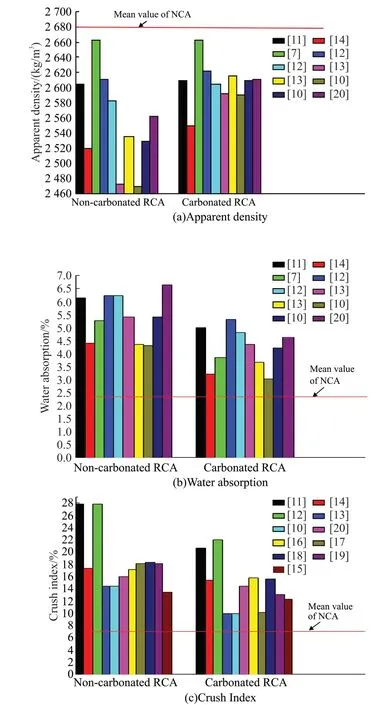
Fig.1 Physical properties of RCA before and after carbonation[7,10-20]

Fig.2 Carbonation mechanism of RCA
At present,the commonly carbonation methods include standard carbonation,pressurized carbonation,circulation carbonation and wet carbonation[21].Among them,the method of pressurized carbonation has the fastest speed and the best effect,so researches on pressurized carbonation are also the most.However,with the carbonation reaction,the dense CaCO3is produced at the surface of carbonated RCA,which also hinders the penetration of CO2,and the carbonation reaction rate is gradually slow.The carbonation degree of RCA depends on the permeability and chemical reactivity of CO2[22].The influencing factors include carbonation conditions (such as carbonation time,CO2concentration,relative humidity,and pressure) and RCA properties (such as particle size,porosity,hydration degree of old mortar,and Ca2+content).The carbonation degree of RCA can be characterized by the width of carbonation band[23],CO2absorption rate[24]or the ratio of carbonation cross-sectional area to total cross-sectional area[25].The recycled fine aggregate with a large specific surface area can react with CO2to generate more CaCO3crystals.Therefore,the carbonation modification effect of recycled fine aggregate is obvious,which is also consistent with the research conclusions of most scholars.While the recycled coarse aggregate with large particle size is carbonated only on the surface[6,22,24,26],and the internal aggregate is still not carbonated.Compared with recycled fine aggregate,the carbonation degree of recycled coarse aggregate is lower.To improve the carbonation degree of recycled coarse aggregate,the research on the carbonation modification of recycled coarse aggregate is mainly based on the better carbonation conditions[6,27]or the provision of multiple calcium sources[17,28].Even if the carbonation effect of recycled coarse aggregate is improved,there is still the surface carbonation problem.Therefore,it is urgent to research methods to realize high-efficiency carbonation modification of recycled coarse aggregate.
Nano-materials have been applied in wide fields,since they have the advantages of small particle size,large specific surface area,strong permeability,high chemical activity,crystal nucleus and micro filling effect.At present,many scholars have studied nano-materials to improve the performance of RAC.The strengthening mechanism can be explained as,since the action of high chemical activity and crystal nucleus of nano-materials,ettringite is formed on the surface of nano-materials,and more Nano-scale C-S-H gel is bonded to form a dense and stable three-dimensional network structure,and the pore structure is filled by nano-materials,thus the mechanical properties and durability of nano-modified RAC can be significantly improved.Studies have shown that[29-32],at the optimum dosage,nano-materials can improve the microstructure,mechanical properties,durability and fracture properties of RAC.The studies on the nano-modified RCA[33-35]show that the old ITZ of nano-modified RCA is denser,the water absorption of nano-modified RCA is reduced,that means the micro and macro properties of nano-modified RCA are improved.Although there are few studies on nano-modified RCA,it is also a potential method for strengthening RCA.
The method of combing nano-materials and pressurized carbonation is expected to solve the problem of only surface carbonation of recycled coarse aggregate,however there are few related studies,and nano-materials are limited to improve the performance of RAC.Zhu[36]firstly carried out the microstructure of modified RAC by combing pressurized carbonation and nano-materials.In the experiment,recycled coarse aggregate was pretreated by accelerated carbonation,and RAC was prepared by adding a certain amount of Nano-SiO2.The optimal carbonation conditions of recycled coarse aggregate and the optimal dosage of nano-SiO2were obtained,and the performance modification of RCA was realized.Li[26,37]proposed a method to modify RCA first by pressurized carbonation and then spraying nano-SiO2.The results show that pressurized carbonation enhances RCA,and nano-SiO2improves the new ITZ of RAC.The results prove that this method has great application potential.However,the role of spraying nano-SiO2after carbonation treatment for RCA is also to improve the performance of RAC.If the recycled coarse aggregate can be modified by soaking or spraying nano-SiO2before carbonation,it is expected to achieve efficient carbonation of recycled coarse aggregate.
Based on the above research results,this paper first proposed the pressurized carbonated modification method for recycled coarse aggregate with nano-SiO2pre-soaking,in order to solve the problem of only surface carbonation of recycled coarse aggregate and realize the high-efficiency carbonation modification of recycled coarse aggregate.In this paper,three different methods of carbonation modified recycled coarse aggregate were compared.The carbonation effect was evaluated,combining with phenolphthalein spraying and CO2absorption rate.The physical indexes such as water absorption,apparent density and crush index of modified recycled coarse aggregate were measured.Then the high efficiency carbonation strengthening mechanism of recycled coarse aggregate was revealed with microscopic analysis combining XRD,SEM,and MIP.The results of this paper have reference significance for the research on the carbonation modification of recycled coarse aggregate and the performance improvement of recycled aggregate concrete.
2 Experimental
2.1 Experimental materials
The recycled coarse aggregate with particle size of 16-19 mm was selected in this paper.C40 concrete beams were cast in laboratory and cured for 28 days,crushed by a jaw crusher,screened to obtain the required particle size of recycled coarse aggregate,the mix proportion of original concrete as shown in Table 1.nano-SiO2and nano-CaCO3with particle sizes of 50 nm were selected as nano-materials.Nano-material dispersant is produced by Hunan Zhongyan Building Materials Science and Technology Co.,Ltd.,China Academy of Building Materials Science.Nano-SiO2solution and nano-CaCO3solution were prepared by ourselves,with mass fractions of 1.5%.CO2concentration is 99.99%,calcium hydroxide solution is saturated Ca(OH)2solution.The nano-materials used in the experiment are shown in Fig.3,and the recycled coarse aggregates after pre-soaking for 24 h are shown in Fig.4.

Table 1 Mix proportion of original concrete/(kg/m3)

Fig.3 Nano-materials used in the experiment

Fig.4 Recycled coarse aggregates after pre-soaking
2.2 Carbonation procedure
In this paper,three carbonation methods of recycled coarse aggregate were used,including carbonation with Ca(OH)2pre-soaking,carbonation with Nano-SiO2pre-soaking and carbonation with Nano-CaCO3pre-soaking.Three kinds of self-made solutions were configured in laboratory,and then according to the carbonation procedure shown in Fig.5.
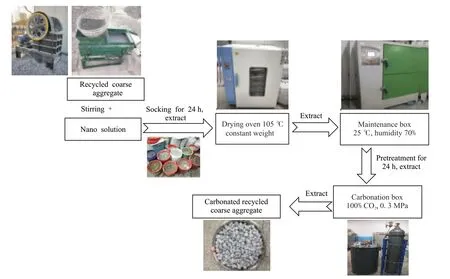
Fig.5 Carbonation procedure
2.3 Experimental tests
2.3.1 Carbonation effect
Phenolphthalein spraying: Scraps on the surface of recycled coarse aggregate were first blown off with a washing ear ball,the carbonated recycled coarse aggregate was cut and smashed,the 1% phenolphthalein solution was sprayed,and then the aggregates and crushed mortar without discoloration were observed.
CO2absorption rate: The recycled coarse aggregate was taken out from the concrete curing box,and about 10 kg samples were weighed respectively.The mass of recycled coarse aggregate before and after carbonation was measured.The mass change rate of recycled coarse aggregate before and after carbonation was calculated according to the following formula,which approximately reflected the CO2absorption rate.
where,m1is the mass of sample before carbonation (kg);andm2the mass of the sample after carbonation (kg).
2.3.2 Physical properties of recycled coarse aggregate
The physical indexes such as water absorption,apparent density and crush index of recycled coarse aggregate before and after carbonation were determined according to the China’s code of “construction pebbles and crushed stones” (GB/T 14685-2011).
2.3.3 Micro-properties of recycled coarse aggregate
(1) Mineral composition analysis
The old mortar attached to the surface of recycled coarse aggregate before and after carbonation was stripped,grinded by a fast grinding machine and through a 200 mesh square hole sieve screen,a certain amount of powder was put into the drying oven,dried at 60 ℃ until constant weight and naturally cooled,then sealed in the sealing bag and marked.Mineral composition of bonded old mortar before and after carbonation was analyzed with rotating target X-ray diffraction (XRD,scanning rate as 5°/min,and scanning range from 5° to 70°).
(2) Surface morphology analysis
The samples containing natural aggregate,old mortar and ITZ were selected from carbonated recycled coarse aggregates with different methods,and were placed in a drying oven,dried at 60 ℃ until constant weight and naturally cooled,then were sprayed with gold.The microstructure of the samples such as the surface morphology of ITZ and attached mortar of recycled coarse aggregate was mainly characterized by scanning electron microscope (SEM).
(3) Porosity analysis
Mercury intrusion porosimeter (MIP,Micrometrics AutoPore IV9500) was used in this work to analysis the porosity of recycled coarse aggregate before and after carbonation.Recycled coarse aggregate with more surface-bonded mortar was selected,cut and weighed about 5.00±0.02 g,placed in 105±5 ℃ drying oven to constant weight,weighed (accurate to 0.01 g),then sealed in the sealing bag and marked.Experimental pressure is from 0.10 to 60000 psia,full scan mode,contact angle is 130°,then pore size calculation is shown as follows:
where,dis the pore size;γthe surface tension of mercury,about 0.485 N/m;θthe contact angle;Pthe pressure.
3 Results and analysis
3.1 Carbonation effect
3.1.1 Phenolphthalein spraying
The spraying phenolphthalein color of surface and internal carbonated recycled coarse aggregate with different methods is shown in Fig.6.It can be seen that the phenolphthalein on the surface of non-carbonated recycled coarse aggregate became red,and no matter what kind of carbonation method,the surface of carbonated recycled coarse aggregate after spraying phenolphthalein did not change color,indicating that the carbonation modification changed the surface pH value and significantly improved the surface characteristics of the recycled coarse aggregate.This is because the hydration product Ca(OH)2in the old mortar on the surface of the recycled coarse aggregate react with CO2to generate dense CaCO3,which reduced the pH value,since phenolphthalein does not change color (pH<8.2).While the phenolphthalein color on the surface of non-carbonated recycled coarse aggregate indicated that the surface of recycled coarse aggregate was rich in Ca(OH)2and alkaline.

Fig.6 Carbonated recycled coarse aggregate after spraying phenolphthalein
Spraying phenolphthalein color of the crushed recycled coarse aggregates in Fig.7 showed that the carbonation effect of the recycled coarse aggregate modified by different carbonation methods was different.The results showed that carbonation with nano-SiO2pre-soaking had the best carbonation effect,followed by carbonation with nano-CaCO3pre-soaking,and finally carbonation with Ca(OH)2pre-soaking.That means that the carbonation effect of carbonated recycled coarse aggregate with pre-soaked Nano-materials obviously improved,which is due to the strong permeability of nano-materials,especially nano-SiO2reacts with hydration product Ca(OH)2to form Nano-scale C-S-H.Under pressurized carbonation,Nano-scale C-S-H can absorb more CO2to generate more stable CaCO3and silica gel,and the solid volume increases by 23.1%[2].Thus the carbonation effect of carbonation with Nano-SiO2pre-soaking is very obvious.Carbonation reaction consumed Ca(OH)2then reduced pH value,so the color of internal spraying phenolphthalein remains unchanged.At the same time,nano-SiO2microfilled pores and improved the microstructure of old mortar and old ITZ.It shows that this method can realize the complete carbonation strengthening of recycled coarse aggregate,and is an efficient carbonation method for recycled coarse aggregate.For the recycled coarse aggregate pre-soaked nano-CaCO3,nano-CaCO3micro-filled the old mortar,while with the carbonation reaction,the carbonation products were wrapped on the surface of nano-CaCO3and the micro-pore,thus the micro-pore structure of modified recycled coarse aggregate was compact.However,there was still non-reacted Ca(OH)2in the core part of recycled coarse aggregate.Therefore,when phenolphthalein was sprayed on the internal recycled aggregate,the core part color was still red.However,due to the immersion of nano-CaCO3,internal Ca2+and OH-migrated to the surface,thereby reducing the internal PH value.when phenolphthalein was sprayed on the internal recycled aggregate,the red color area was small.For the carbonation with Ca(OH)2pre-soaking method,since the surface of recycled coarse aggregate was rich in Ca2+,under pressurized carbonation,CO2first react with the surface Ca2+to generate a large number of dense CaCO3.With the carbonation reaction from the outside to inside,the penetration of CO2was hindered,there was still much non-reacted Ca(OH)2in the internal recycled coarse aggregate,so internal spraying phenolphthalein color of the crushed recycled coarse aggregate was red,and the red color area was larger.
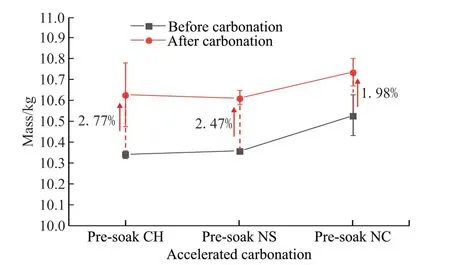
Fig.7 Mass of recycled coarse aggregate before and after carbonation
3.1.2 CO2absorption rate
Mass of recycled coarse aggregate before and after carbonation with different carbonation methods is shown in Fig.7.It can be seen that the carbonation quality improvement rate of pre-soaked Ca(OH)2carbonated recycled coarse aggregate was the highest (2.77%),followed by pre-soaked Nano-SiO2carbonated recycled coarse aggregate (2.47%),and the carbonation quality improvement rate of pre-soaked nano-CaCO3carbonated recycled coarse aggregate was the lowest (1.98%).The results indicate that the CO2absorption rate of several carbonation methods were in the order of carbonation with Ca(OH)2pre-soaking >carbonation with nano-SiO2pre-soaking >carbonation with nano-CaCO3pre-soaking.The reason was analyzed as following: Presoaked Ca(OH)2provided more Ca2+for recycled coarse aggregate,thereby more CO2was absorbed to generate CaCO3,and the solid volume increased by 11.5%[2].However,with the carbonation reaction,the CO2permeability rate decreased,which affected the carbonation effect of recycled coarse aggregate.For recycled coarse aggregate pre-soaked Nano-SiO2,nano-SiO2penetrated into the pores of the old mortar,and reacted with the hydration product Ca(OH)2to bond more nano-scale C-S-H gels.Under pressurized carbonation,these Nano-scale C-S-H gels can absorb more CO2,and generate more stable and dense CaCO3and silica gel.After recycled coarse aggregate was pre-soaked nano-CaCO3,nano-CaCO3micro-filled the pores of old mortar,and some internal Ca2+and OH-migrated to the surface.Under pressurized carbonation,CO2first reacted with the surface hydration product Ca(OH)2,but with the carbonation reaction,CO2permeation rate decreased and CO2absorption rate was the lowest.
3.2 Physical properties analysis of carbonated recycled coarse aggregate
Physical properties of recycled coarse aggregate with different carbonation methods are shown in Table 2.Water absorption of carbonated recycled coarse aggregate was significantly improved,and apparent density and crush index were improved to some extent.

Table 2 Physical properties of recycled coarse aggregate with different carbonation methods
3.2.1 Water absorption of carbonated recycled coarse aggregate
Water absorption of recycled coarse aggregate modified by different carbonation methods is shown in Fig.8.It can be seen that water absorption of carbonated recycled coarse aggregate was significantly reduced,especially the reduction of carbonation with nano-SiO2pre-soaking and carbonation with Nano-CaCO3pre-soaking was the most obvious,with the maximum reduction of 23.03%.It can be explained that nano-SiO2and nano-CaCO3micro-filled the micro-cracks of recycled coarse aggregate and the pores of old mortar,after pressurized carbonation,the carbonation reaction products wrapped on the surface of Nanomaterials,thus the micro structure of modified recycled coarse aggregate was more compact.Therefore,the water absorption of modified recycled coarse aggregate with pre-soaked nano-SiO2carbonation and pre-soaked nano-CaCO3carbonation was far less than that of modified recycled coarse aggregate with pre-soaked Ca(OH)2carbonation.
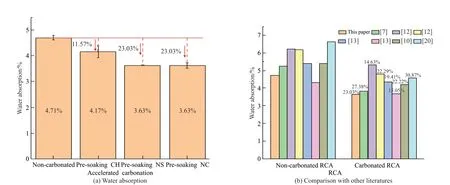
Fig.8 Water absorption of modified recycled coarse aggregate
Compared with previous Refs.[7,11-13,20](Fig.8(b)),the reduction of water absorption of carbonated recycled coarse aggregate in this paper was very remarkable,except Asghar Gholizadeh-Vayghan[7](water absorption decreased by 27.38 %) and Guo[20](water absorption decreased by 30.87%).The reason was that the initial water absorption of recycled coarse aggregate used in the two tests (5.26% and 6.64%,respectively) was higher than that in this paper (4.71%).The pores of old mortar were larger,and the carbonation degree of raw materials was higher.While the carbonation time for Guo’s experiment was long (longer than 7 days).In this paper,the carbonation time is 24 h,and water absorption of carbonated recycled coarse aggregate (3.63%) is the smallest compared with that in other literatures,which also proves the efficiency of carbonation modification method in this paper.
3.2.2 Apparent density of carbonated recycled coarse aggregate
Consistent with other literature conclusions,the apparent density of carbonated recycled coarse aggregate had a certain degree of improvement,seen in Fig.9.
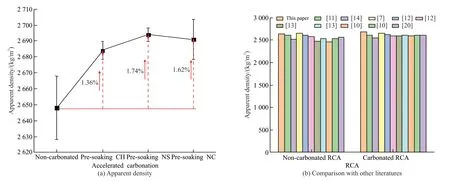
Fig.9 Apparent density of modified recycled coarse aggregate
Among the three carbonation methods in this paper,the apparent density improvement of modified recycled coarse aggregate with pre-soaked Nano-SiO2was the most obvious,with the maximum increase of 1.74%.The apparent density improvement of modified recycled coarse aggregate with pre-soaked nano-SiO2and pre-soaked nano-CaCO3was more obvious than that of pre-soaked Ca(OH)2.The main reason was that the double filling effect of nano materials and carbonation products was enhanced.In particular,the recycled coarse aggregate pre-soaked nano-SiO2react with hydration product Ca(OH)2to bond more nano-scale C-S-H gel,which can absorb more CO2,accelerated the carbonation reaction,and generated more stable and dense CaCO3and silica gel.The solid volume increase rate was larger than that of Ca(OH)2carbonation reaction.Carbonation with nano-SiO2pre-soaking realized the bidirectional enhancement of nano-materials and pressurized carbonation,and the micro cracks of recycled coarse aggregate and the pores of old mortar were more dense.
3.2.3 Crush index of carbonated recycled coarse aggregate
The crush index of carbonated recycled coarse aggregate decreased.Since the initial crush index of recycled coarse aggregate in this paper was smaller,the crush index reduction was slightly compared with other literatures.The modified recycled coarse aggregate with pre-soaked nano-SiO2had the best improvement in crush value,with a decrease of 3.7%,as shown in Fig.10.
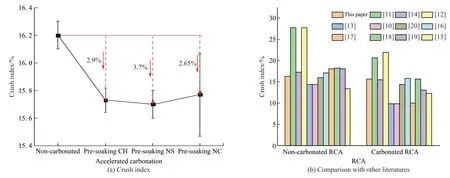
Fig.10 Crush index of modified recycled coarse aggregate
The crush index improvement effect of carbonation with pre-soaked nano-CaCO3and carbonation with pre-soaked Ca(OH)2was close,and the reduction rate was 2.65% and 2.9%,respectively.The reason was that these two methods mainly individually played the advantages of nano-materials and pressurized carbonation,and the improvement effect was weaker than that of carbonation with pre-soaked nano-SiO2.Carbonation with pre-soaked nano-SiO2realized the bidirectional enhancement of nano-materials and pressurized carbonation,improved the CO2absorption rate,accelerated the carbonation reaction,generated more stable CaCO3and Nano-scale silica gel,and binded to a dense three-dimensional network structure.
3.3 Micro-properties analysis of carbonized recycled coarse aggregate
3.3.1 XRD analysis Fig.11 shows the XRD patterns of non-carbonated and carbonated recycled coarse aggregate,in which only the main peaks of Ca(OH)2and CaCO3related to the carbonation process were marked and discussed.
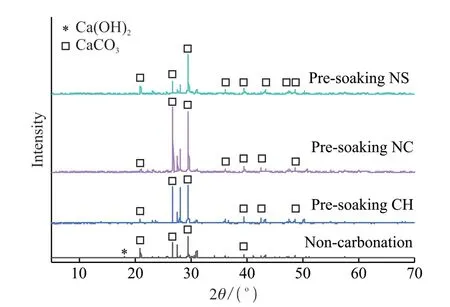
Fig.11 XRD patterns of recycled coarse aggregate
Fig.11 shows that obvious peak Ca(OH)2is detected in the hydration products of non-carbonated recycled coarse aggregate(the characteristic peak appeared at 18.1°,and the intensity was 378 au).The obvious peak of Ca(OH)2for recycled coarse aggregate treated with different carbonation methods disappeared,and the CaCO3peak increased.The XRD test data showed that the intensity of Ca(OH)2for carbonated recycled coarse aggregate with Ca(OH)2pre-soaking,nano-CaCO3pre-soaking and Nano-SiO2pre-soaking was 98,53,and 43 au,respectively,indicating that the carbonation reaction consumed Ca(OH)2.The characteristic peak of CaCO3was obviously detected at 2θrange from 26° to 30°,which verified the formation of CaCO3.It is consistent with the analysis results of mass change rate before and after carbonation in Fig.8.In addition,the peak strength of carbonated recycled coarse aggregate pre-soaked Nano-materials was much higher than that of non-carbonated recycled coarse aggregate.The peak strength of CaCO3for carbonated recycled coarse aggregate with nano-CaCO3pre-soaking was the highest,followed by nano-SiO2pre-soaking and Ca(OH)2pre-soaking.This is due to the strong permeability of nano-CaCO3,which filled micro cracks of recycled coarse aggregate and old mortar pores.The pre-soaked nano-SiO2react with Ca(OH)2to bond more nano-scale C-S-H gel,which can absorb more CO2and accelerate the carbonation reaction,and generated more CaCO3,so the peak strength of CaCO3is higher than that of carbonated recycled coarse aggregate with Ca(OH)2pre-soaking,which was consistent with the analysis results in Section 3.2.
3.3.2 SEM images
The surface morphology of recycled coarse aggregate with various carbonation treatments is shown in Fig.12.It can be seen that the structure of the old mortar and ITZ of the non-carbonated recycled coarse aggregate was loose,and there were micro cracks with a width of about 5 μm in Fig.12(a),which proved that ITZ is the weakest phase of the recycled coarse aggregate[38],and calcite was found on the surface of the non-carbonated recycled coarse aggregate,indicating that the recycled aggregate was carbonated in the air,but the natural carbonation rate is very slow (about 10-8cm2/s)[39],and the carbonation effect is far lower than that of pressurized carbonation.The old mortar and ITZ structure of carbonated recycled coarse aggregate with Ca(OH)2pre-soaking were denser than non-carbonated recycled coarse aggregate,and the width of micro cracks was less than 5 μm.This is due to the filling of pores by calcium carbonate generated by carbonation reaction,which makes the old mortar and ITZ structure more dense.However,due to the low carbonation degree in recycled coarse aggregate,the effect of improving micro cracks is limited.The microstructure of old mortar and ITZ of carbonated recycled coarse aggregate pre-soaked nano-materials was significantly improved,especially carbonated recycled coarse aggregate pre-soaked nano-SiO2.A dense three-dimensional network structure was shown in Fig.12(d).
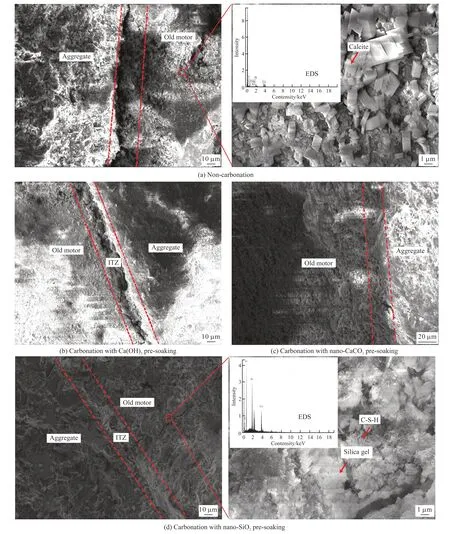
Fig.12 SEM images of modified recycled coarse aggregate
3.3.3 MIP analysis
The relationship between cumulative intrusion and incremental intrusion and pore size of carbonated recycled coarse aggregate is shown in Fig.13.

Fig.13 Pore size of modified recycled coarse aggregate
As expected,the pore structure of carbonated recycled coarse aggregate with nano-SiO2pre-soaking was the most dense,and the MIP test data also showed that for non-carbonated recycled coarse aggregate,carbonated recycled coarse aggregate with Ca(OH)2pre-soaking,carbonated recycled coarse aggregate with nano-CaCO3pre-soaking and carbonated recycled coarse aggregate with nano-SiO2pre-soaking,the porosity was 22.80%,19.94%,20.31%,and 12.77%,respectively and the average pore diameter was 38.72,27.06,25.77,and 21.82 nm,respectively,which is consistent with the analysis results of the previous section.The reason is that nano-SiO2react with Ca(OH)2of the old mortar to nano-scale C-S-H,which refined the internal microstructure.Under pressurized carbonation,nano-scale C-S-H absorbed more CO2to form CaCO3and nano-scale silica gel,that means the pore filling ability is stronger and the pore structure is more compact.In this paper,porosity of carbonated recycled coarse aggregate with Nano-SiO2pre-soaking was reduced by 44.06% than non-carbonated recycled coarse aggregate,indicating that the method of carbonation with nano-SiO2pre-soaking is a high-efficiency carbonation modification for recycled coarse aggregate.
4 Discussion
To increase the application range of recycled coarse aggregate and improve the comprehensive utilization rate of construction waste resources,scholars have put forward many strengthening methods for recycled coarse aggregates[2,40,41].The strengthening mechanism is mainly divided into stripping old mortar and strengthening old mortar.Whether it is particle shaping[42],microwave heating[43],soaking strong acid[44]or soaking weak acid[45],the stripping old mortar methods can strengthen the recycled coarse aggregate to a certain extent,but there are defects such as time-consuming,energy consumption and environmental pollution.At present,more research focuses on the strengthening old mortar.Surface modification of silica fume and fly ash[46],Nano-materials[34],crystallization agent (CA)[47]and microbial mineralization strengthening[48,49]can refine the pore structure of old mortar and improve the performance of recycled coarse aggregates.Carbonation strengthening[50-52]recycled coarse aggregate captures and isolates greenhouse gas CO2at the same time,which is an environmentally friendly strengthening method of recycled coarse aggregate and has become a research hot-spot of recycled aggregate modification.However,with the carbonation reaction,the dense pore structure also hinders the further penetration of CO2,and the carbonation rate is slow,especially the recycled coarse aggregate with large particle size only has surface carbonation,and the carbonation strengthening effect is affected.At present,the research on carbonation modified recycled coarse aggregate improves its carbonation effect mainly by regulating the optimal carbonation conditions and providing multiple calcium sources.Although the carbonation depth increases,there is still the problem of only surface carbonation for modified recycled coarse aggregate.
In this paper,the method of pressurized carbonation for recycled coarse aggregate with Nano-materials pre-soaking was proposed for the first time,and the high-efficient carbonation modification of recycled coarse aggregate was realized.Based on the results of this study,the modification effects of recycled coarse aggregate under three different carbonation methods are quite different,because of fundamentally different strengthening mechanism.The strengthening mechanism of carbonation with Ca(OH)2pre-soaking can be explained as that the surface and internal pores of presoaked Ca(OH)2recycled coarse aggregate are rich in Ca2+and OH-.Under pressurized carbonation,CO2first reacts with Ca2+rich on the surface to form CaCO3,and the solid volume increased by about 11.8%.Since presoaked Ca (OH)2provides more Ca2+,CO2absorption level increases.The carbonation reaction proceeds from the surface to the interior.The hydration products Ca(OH)2,C-S-H and non-hydrated particles C2S and C3S of the old mortar also react with CO2to generate CaCO3and silica gel with increased solid volume,The carbonation reaction refines the pore structure of the old mortar and strengthens the performance of recycled coarse aggregate.However,with the carbonation reaction,CaCO3and silica gel fill pores,which also hinder the penetration of CO2and slow down the carbonation reaction.There is still much non-reacted Ca(OH)2in the internal recycled coarse aggregate,so internal spraying phenolphthalein color of the crushed recycled coarse aggregate is red,and the red color area is more obvious.
For carbonation with nano-CaCO3pre-soaking,Pre-soaked nano-CaCO3micro fills the old mortar pores,while some part of Ca2+and OH-in the internal pore migrates to surface.Under pressurized carbonation,the hydration product Ca(OH)2of old mortar reacts with CO2to form CaCO3with increased volume,attached to the surface of nano-CaCO3.The carbonation reaction also promotes the migration of Ca2+and OHto surface.With the consumption of Ca2+,the hydration product C-S-H of the old mortar releases Ca(OH)2continuously,which reduces the pH value and promotes the carbonation reaction.The carbonation products change under different pH values.Lagerblad[53]divided the whole process of carbonation reaction into five stages,as shown in Table 3.Carbonation reaction products adhere to the surface of nano-CaCO3,filling pores,so carbonation reaction rate is slow.But there is still less non-reacted Ca(OH)2in the internal recycled coarse aggregate,so internal spraying phenolphthalein color of the crushed recycled coarse aggregate is red,and the red color area is larger than that of carbonation with Ca(OH)2pre-soaking.
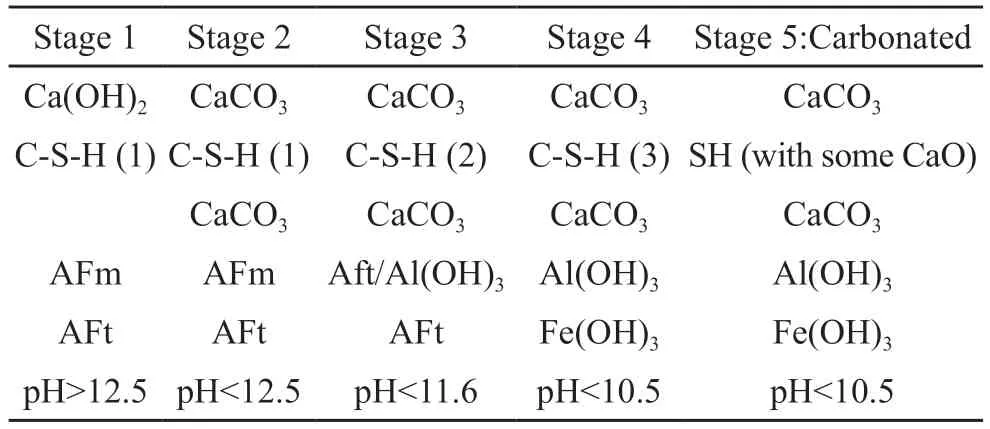
Table 3 Five stages of carbonation reaction for cement paste
The modified recycled coarse aggregate by carbonation with nano-SiO2pre-soaking can achieve bidirectional enhancement of nano-materials and pressurized carbonation,improve the CO2absorption rate,accelerate the carbonation reaction.This is because the pre-soaked nano-SiO2firstly bonds with the hydration product Ca(OH)2of the old mortar to nano-scale C-S-H,which consumes Ca(OH)2and promotes the decomposition of Ca(OH)2by the hydration product C-S-H,so that it continues to react with Nano-SiO2to bond more nano-scale C-S-H and refine the internal microstructure.Under pressurized carbonation,nano-scale C-S-H can absorb more CO2to form CaCO3and nano-scale silica gel,and the solid volume increases by 23.1%[2].That means for carbonated recycled coarse aggregate with Nano-SiO2pre-soaking,the carbonation effect is more obvious,the pore filling ability is stronger and the microstructure is more compact.The interior of the modified recycled coarse aggregate is also strengthened,and the PH value is reduced.Therefore,the internal spraying phenolphthalein does not change color,and the high efficient carbonation modification of recycled coarse aggregate is realized.
5 Conclusions
In this paper,the carbonation effect,physical properties and microstructure of modified recycled coarse aggregate under three different carbonation methods were analyzed by means of macroscopic physical index test and XRD,SEM,and MIP.The following conclusions are reached:
a) The physical properties and microstructure of carbonated recycled coarse aggregate were improved,but due to the influence of CO2permeability and chemical reaction,there is a problem of only surface carbonation for the modified recycled coarse aggregate.
b) Carbonated recycled coarse aggregate with pre-soaked Nano-materials can significantly improve the carbonation effect,physical properties and microstructure of recycled coarse aggregate.Especially the carbonation with pre-soaked nano-SiO2can realize the complete carbonation of recycled coarse aggregate and achieve the purpose of high-efficient carbonation modification.The carbonation effect of the three carbonation methods in this paper is as follows: carbonation with nano-SiO2pre-soaking>carbonation with nano-CaCO3pre-soaking>carbonation with Ca(OH)2pre-soaking.
c) Carbonated recycled coarse aggregate with nano-SiO2pre-soaking has the most obvious physical properties improvement and the most dense microstructure.The water absorption and porosity of carbonated recycled coarse aggregate with nano-SiO2pre-soaking were decreased significantly by 23.03% and 44.06%,respectively.
d) Carbonation with nano-SiO2pre-soaking can achieve bidirectional enhancement of nano-materials and pressurized carbonation.The strengthening mechanism is explained as following,pre-soaked nano-SiO2can bond more nano-scale C-S-H with the hydration products Ca(OH)2and C-S-H of old mortar (C-S-H can release Ca(OH)2).Under pressurized carbonation,nano-scale C-S-H can absorb more CO2,accelerate the carbonation reaction,generate more stable CaCO3and nano-scale silica gel,bond dense three-dimensional network structure,and realize the high efficiency carbonation of recycled coarse aggregate.
Although the carbonation effect,physical properties and microstructure of carbonated recycled coarse aggregate with pre-soaked nano-SiO2were analyzed by different means,and the mechanism of high-efficiency carbonation strengthening was revealed,the mechanical properties,durability and microstructure of modified recycled coarse aggregate concrete with this method were not studied.It is still necessary to develop the supporting equipment of this technology to facilitate its engineering application,explore the recycling of low concentration CO2produced by industrial exhaust gas,and achieve the dual goals of resource utilization and high efficiency carbonation of recycled coarse aggregate.
Conflict of interest
All authors declare that there are no competing interests.
 Journal of Wuhan University of Technology(Materials Science Edition)2024年2期
Journal of Wuhan University of Technology(Materials Science Edition)2024年2期
- Journal of Wuhan University of Technology(Materials Science Edition)的其它文章
- Biotin-modified Galactosylated Chitosan-gene Carrier in Hepatoma Cells Targeting Delivery
- Mussel-inspired Methacrylic Gelatin-dopamine/Ag Nanoparticles/Graphene Oxide Hydrogels with Improved Adhesive and Antibacterial Properties for Applications as Wound Dressings
- Effect of Polyvinyl Alcohol in Inner Aqueous Phase on Stability of Millimeter-scale Capsules
- Synthesis and Characterization of Nonionic Waterborne Polyurethane and Application to Wool Fabric Finishing
- Fluorescent Double Network Hydrogels with Ionic Responsiveness and High Mechanical Properties for Visual Detection
- Damage Mechanism of Ultra-thin Asphalt Overlay (UTAO)based on Discrete Element Method
